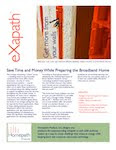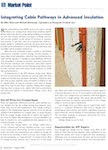Recently Intel unveiled an R & D project at the Intel Developers Forum called “Light Peak. While few details were shared, much is known about the technologies enabling this project and what their implications are. This is the first of several postings that will describe the promise this technology holds, its practicality, and how consumers may respond.
The arduous path of technology
In 1995 I visited NEC world headquarters in Tokyo, Japan. I entered through the main lobby. Tidy and well organized but otherwise unremarkable. Strolling past what appeared to be a tropical fish tank I soon realized the mesmerizing image was being broadcast on a monitor. I had stumbled into technology called High Definition Television. This was big news. Markedly better t
han what I had at home. I figured it would make its way to the US soon.
HDTV did finally show up…about ten years later. For many reasons that I will not cover here, HDTV’s introduction in the US was delayed. When it did arrive its adoption ramped up quickly and is now taken for granted. Technology is odd that way. While it may make perfect sense it often takes significant time to clear all hurdles necessary for general market acceptance.
MP3 players provide another good example of this-and until Apple provided the value necessary for success with their iPod line, MP3 players were more a curiosity. Apple, combining improvements provided by components suppliers, elegant software, and resolution to entertainment licensing obstacles brought us the iPod…a luxurious novelty to start that is now ubiquitous.
Apple solved size, storage, speed, quality, legal, user friendliness and styles issues before seeing commercial success.
Every now-and-then a noteworthy technology emerges. One to learn about and track through its arduous path from the lab to the shelves at Best Buy. Intel’s “Light Peak” project is an agglomeration of enabling technologies. Combining to overcome hurdles and create a new era for consumer electronics value.
What is “Light Peak” from Intel?
I know as much about “Light Peak” as is publicly available to me. A great deal of information is circulating, some accurate, some speculative. Fortunately Intel provides a video that you can see here: Light Peak to Connect Consumer Devices at Record Speed (for the record, I am not affiliated with or sponsored by Intel in any way)
The video makes the following noteworthy claims:
- “Light Peak” will use an optical fiber rather than copper wires for signal distribution between equipment
- Initial transmission of 10Gigabits per second (Gb/s)
- Scalable to 100Gb/s
- Optical fiber demonstrated has a diameter of 125 microns (µm)
- Chip size dramatically reduces size over conventional optical tansceiver modules of similar performance
- Chip promises “order of magnitude” reduction in transceiver cost.
- Dual light emitting devices on the chip…notably referred to as lasers
- Bidirectional communication built in
We will witness a new round of innovation associated with Intel’s “Light Peak” approach should it come to market. These changes will seem similar to those encountered when USB (Universal Serial Bus) was first used. USB caused major change when initially introduced. Consumers have now adopted USB 1.0. Subsequently we evolved through USB 2.0, taking full advantage of the improvements in data transfer speed. USB 3.0 looms, promising a tenfold improvement in transfer speed and will undoubtedly see rapid adoption.
The frame of reference for USB deals with device-to-device connection over short distance. “Light Peak” promises dramatically improved data transfer…and greater distance…perhaps affecting the cables we install in our walls.
What could Intel be up to with the “Light Peak” project?
They will establish an entirely new arena of performance, dramatically improving data transfer rates and adding an entirely new dimension related to distance…extending performance and reach beyond what USB can provide. Additionally, “Light Peak” will solve the technical hurdles encountered with HDMI (high definition multimedia interface) related to cable size, stiffness and limited length.
This is a program worth monitoring. With an eye toward home design and construction, this thread will explore many of the technical, market and consumer affects in future posts.






.jpg)


No comments:
Post a Comment